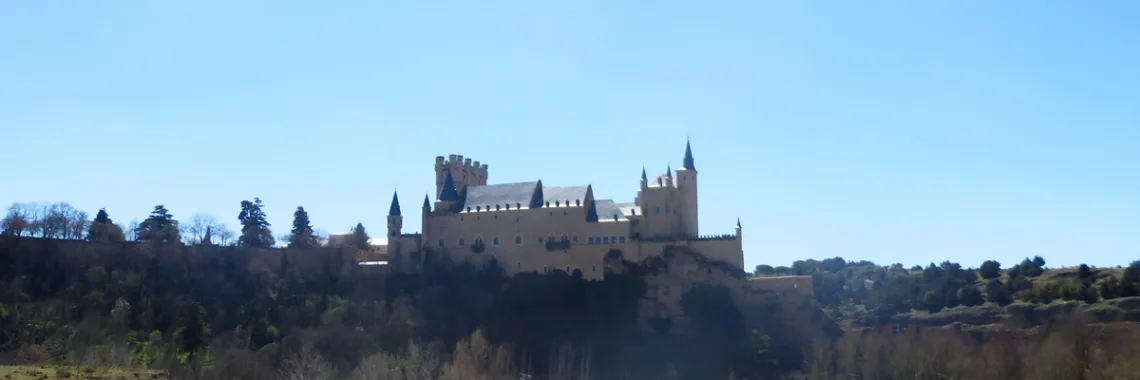
Entering the Alcázar (Castle) of Segovia, Spain: the astonishing fortress of Medieval origins and its old stories that reveal the Kingdom of Castile’s turbulent past
Segovia is a historic city renowned for its rich cultural heritage and stunning architectural landmarks. One such landmark, the Alcázar castle, sits atop a craggy hill overlooking the city. It serves as a symbol of Segovia’s rich history.
The castle’s unique design, featuring a mix of Gothic and Islamic architectural styles, has earned it a place among Spain’s most iconic sites. It is, indeed, an enchanting place with a rich history and a captivating story to tell. When I visited this old fortress, I felt I travelled back in time to the days of medieval knights and castles. With all the magic and wonder that such a place holds…
In this article, we will take a closer look at the Alcázar castle of Segovia. We will delve into its rich history, stunning architecture, and cultural significance.
“Everybody is equally weak on the inside, just that some present their ruins as new castles and become kings ”
Simona Panova
The History of the Alcázar Castle of Segovia
The Alcázar Castle of Segovia is a timeless monument of Spain’s rich history. Its origins date back to the late 12th century, when King Alfonso VIII built it as a fortification.
Over the centuries, the castle served numerous purposes, including a royal palace, a military fortification, and even a prison. Throughout its long history, the building witnessed many significant events and periods. It played a crucial role in the defense of Segovia and the Kingdom of Castile.
In its early days, the castle served as a palace for the royalty of Castile, providing a secure and luxurious residence for the monarchs. Over time, it was modified and expanded to better suit its role as a military fortification, with the addition of towers, walls, and battlements.
Furthermore, it was a key for the protection of Segovia during the tumultuous medieval period. Then, the Kingdom endured constant threats of invaders and rival factions.
During the reign of King Philip II in the 16th century, the castle was as a prison, holding some of Spain’s most notorious criminals. However, despite its dark history as a place of confinement and punishment, the Alcázar has always inspired admiration for its architectural beauty and iconic status as one of Spain’s most recognizable landmarks.
Today, the castle is a testament to Spain’s rich history. It attracts tourists from around the world to admire its stunning architecture and learn about its fascinating past.
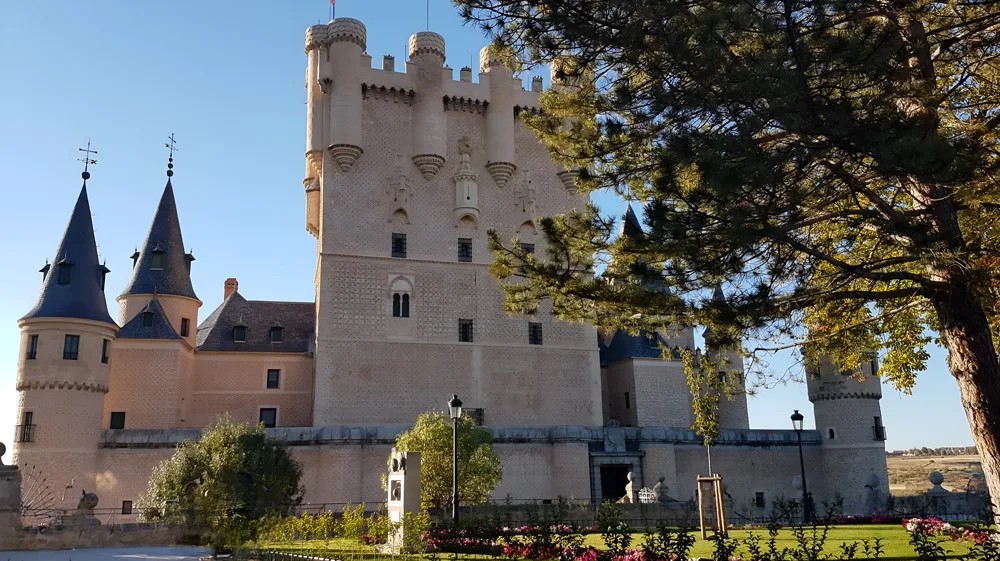
The Architecture and Design of the Alcázar Castle of Segovia
The Alcázar of Segovia is a magnificent piece of architecture and design. It combines elements of Gothic and Islamic styles in a unique and striking structure.
This castle stands tall on a hill and boasts an irregular layout that blends perfectly with its surroundings. It is divided into two areas. The exterior with a Herrerian patio, moat, drawbridge, and the Tower of Homage. The interior, with a chapel and several noble rooms.
The exterior (defensive) structure of the Alcázar
The exterior structure of the Alcázar castle in Segovia, Spain, was designed to provide a strong defense against attackers. Its location on a rocky hill and its shape, combining the advantages of a palace and those of a fortress, made it a formidable stronghold.
The castle’s walls are made of stone and are up to 30 meters high in some places. They are thick and reinforced with towers and bastions at strategic points. Therefore, providing excellent visibility and allowing the defenders to respond quickly to any threats.
The entrance to the castle goes through a drawbridge and a gate, which could close in times of danger.
The castle also features a 26-meter-deep defensive moat. This is now crossed by a stone bridge built during the reign of Philip II and an iron walkway.
Overall, the exterior structure of the Alcázar castle stands out for its formidable resistance, making it a difficult target for attackers and ensuring the safety of its inhabitants.
The towers of the Alcázar castle of Segovia
One key element that draws attention is its lofty architecture, with its tall, pointed towers reaching up toward the sky. These towers were not only built for defensive purposes. They also to showcase the power and prestige of the castle’s owners. The impressive height of the towers also offers breathtaking views of Segovia and the surrounding landscape.
The Tower of Juan II
For example, The Tower of Juan II, built between 1440 and 1465, is a stunning example of Spanish Gothic Civil architecture. It served as a state prison and symbolized the absolute power of the Spanish monarchy.
This tower is 80 meters tall, divided into three floors, and adorned with circular engravings and battlements. Some of these, decorated with the Castilla coat of arms. You must climb 152 steps up the spiral staircase to reach the top and enjoy a breathtaking 360-degree view of the city and its surroundings.
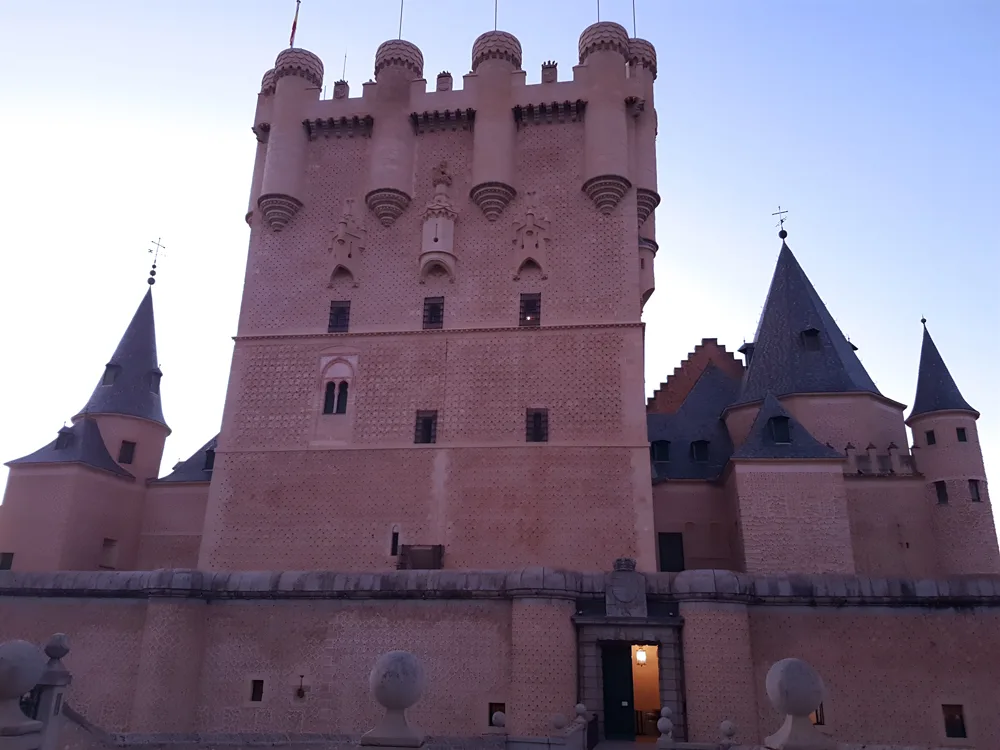
The courtyards of the Alcázar
Another critical aspect of the castle’s design are its spacious courtyards. They provide a peaceful and serene respite from the bustle of the city below. These courtyards served many purposes, including gathering spaces for court events and training grounds for the castle’s soldiers.
For example, the so-called “terrace of Moors” (a walled terrace that extends along the castle’s front) served as a lookout for Enrique IV’s Moorish guard.
The interior of the Alcázar castle of Segovia
In addition to its impressive towers and spacious courtyards, the Alcázar Castle features artworks highlighting its intricate and luxurious design. From its complex stonework to its elaborately carved wooden doors and windows, the castle is a feast for the eyes and a true testament to the skill and creativity of its builders.
The Hall of the double windows or “Sala de Ajimeces”
The “Sala de Ajimeces” is one of the oldest in the castle, dating back to the 12th century under King Alfonso VIII. This room was the main space of the former residence of the Bourgogne dynasty and served as a location for courtly celebrations.
It gets its name from the four double windows, known as “ajimeces”, that once overlooked the Eresma river.

The Fireplace Room or “Sala de la Chimenea”
The “Sala de la Chimenea” was built under Philip II and features 16th-century furnishings. On the walls, you can see portraits of Philip II and III, a 16th-century Flemish tapestry depicting the betrothal of Our Lady. It is also a unique representation of the Alcázar before its roof reform and the former Santa Mara cathedral located in the current Alcázar square.
The Throne Hall or “Sala del Trono”
The Throne Hall (or Solio) features a mudéjar decorated portal that leads to the Sala de la Chimenea.
The room has an octagonal ceiling, similar to the one destroyed in the fire, carved in 1456. Underneath, there is a wide plaster frieze that maintains its original decoration, with Gothic-style images of animals and plants.
In the center of the room there is a throne, carved in 1559, now restored to its former glory.
The Ambassadors Room or “Sala de Embajadores”
This magnificent Hall was built in 1412 by Queen Catherine of Lancaster during her son’s minority reign. It was once home to the “Sala de Embajadores”, where guests eagerly awaited an audience with royalty.
Chronicles of the time described this room as the most beautiful in the palace. With its stunning wooden, golden, and polychrome ceiling, it reminisced the main chapel of the Santa Clara convent in Tordesillas.
Tragically, the ceiling was destroyed in a fire in 1862 but was masterfully restored in 2000. The reconstruction was carried out by skilled carpenter Juan Givaja and his team. They used cedar wood and four kilograms of gold to bring the ceiling back to its former glory.
On the room’s southern wall, you can still see the original configuration of the north facade of the Old Palace (the Sala de Ajimeces) before the added galley truss.
The windows boast two stunning stained-glass depictions created by Muñoz de Pablos, portraying Enrique II the Mercedes and Enrique III the Doliente. And also, the murder of Pedro the Cruel and the death of Enrique II’s son from a horse fall.
These stained-glass windows are based on 16th-century miniatures by Hernando de Ávila, now kept in the Monastery of the Escorial.
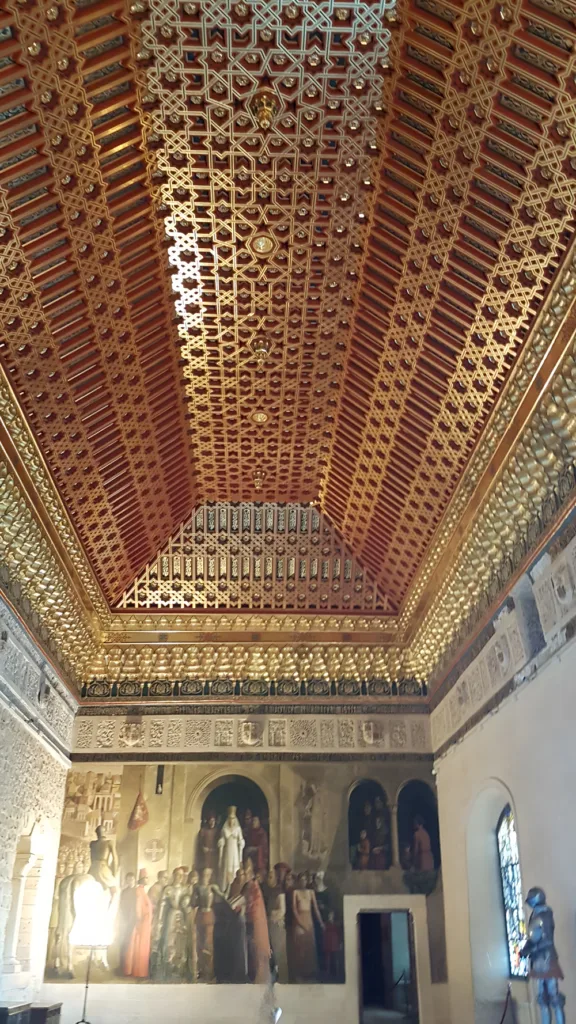
The Weapon Room or “Sala de Armas”
The Weapon Room is the home of the Trastámara family’s armory and the precursor of Madrid’s Royal Armoury collections. This room reflects the military style of the Alcázar, featuring a barrel-vaulted ceiling and double-paned windows.
It is located on the ground floor of the Torre del Homenaje. Currently, it houses a vast collection of armor pieces, swords, spears, halberds, mortars, culverins, and bombards antique flags with heraldry.
The “Carlos V ballista,” thought to have belonged to the emperor, is one of the room’s highlights. It stands out for its ornamental richness and similarity to the one seen in a painting by Lucas Cranach, also in the room.
The Chamber of the Treasure or “Cámara del Tesoro”
A small door with delicate Romanesque grates from the Sala de Armas leads to this ancient chamber, which was once used to store the wealth of the Kingdom.
The Alcázar was not only a palace but also the guardian of the fabulous treasures of the Trastámara.
The fortress treasurer oversaw safeguarding the treasure. Along with the governor, it is one of the oldest professions in Segovia, dating back to 1088.
According to the chronicles, the last money to leave this chamber went to finance Columbus’ voyage to the Americas. After the death of Queen Isabella, most of the royal treasure was lost. Today, the Chamber of the Treasure only houses some old chests with sophisticated locks, a testament to what it was in times past.
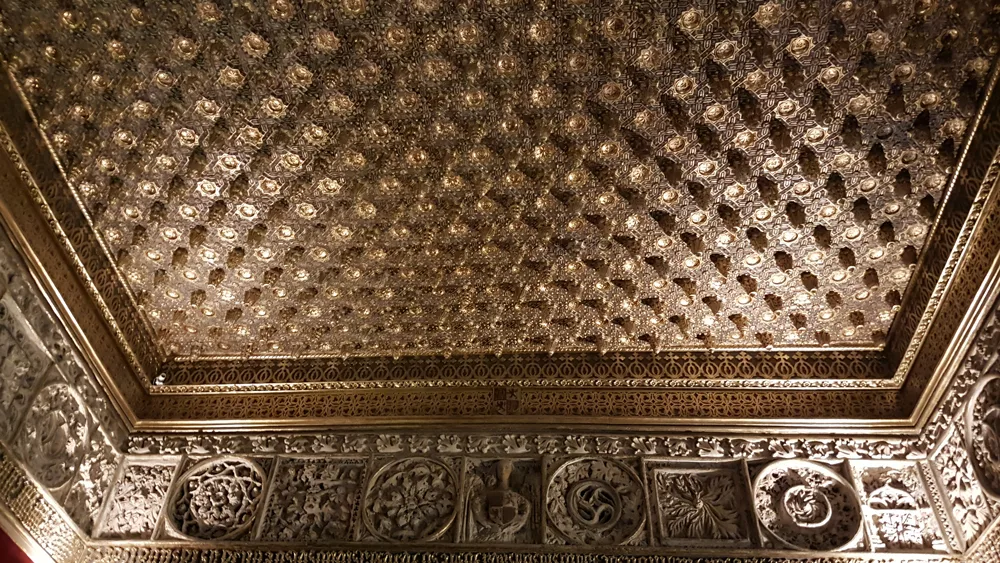
Renovations and restorations
Over the years, the Alcázar castle has undergone several renovations and restorations to maintain its appearance and functionality. These renovations have helped preserve it and bring it up to modern standards and make it more accessible to visitors.
Despite these alterations, the castle remains unchanged, with its unique architectural and design features for future generations to enjoy.
The Significance of the Alcázar Castle of Segovia
The Alcázar castle of Segovia has stood tall and proud for centuries, offering a fascinating glimpse into the rich history of Spain. Built in the 11th century, this magnificent building has played a crucial role in the country’s past. It served as a palace, a military fortification, and even a prison.
Its unique architectural style, mixing Gothic and Islamic elements, has earned its recognition as one of the most important historical monuments in the country. It is a cultural, historical, and architectural treasure, both for Segovia and for Spain as a whole. Its significance lies in its ability to tell the story of the country’s rich past and its unique cultural heritage. Therefore, the Alcázar castle is a UNESCO World Heritage Site, which recognizes its importance to the cultural heritage of humanity.
Visitors can admire its impressive towers, spacious courtyards, and ornate decorations, all hallmarks of the castle’s unique architectural style. Its well-preserved state, with multiple renovations and restorations over the years, adds to its significance and appeal.
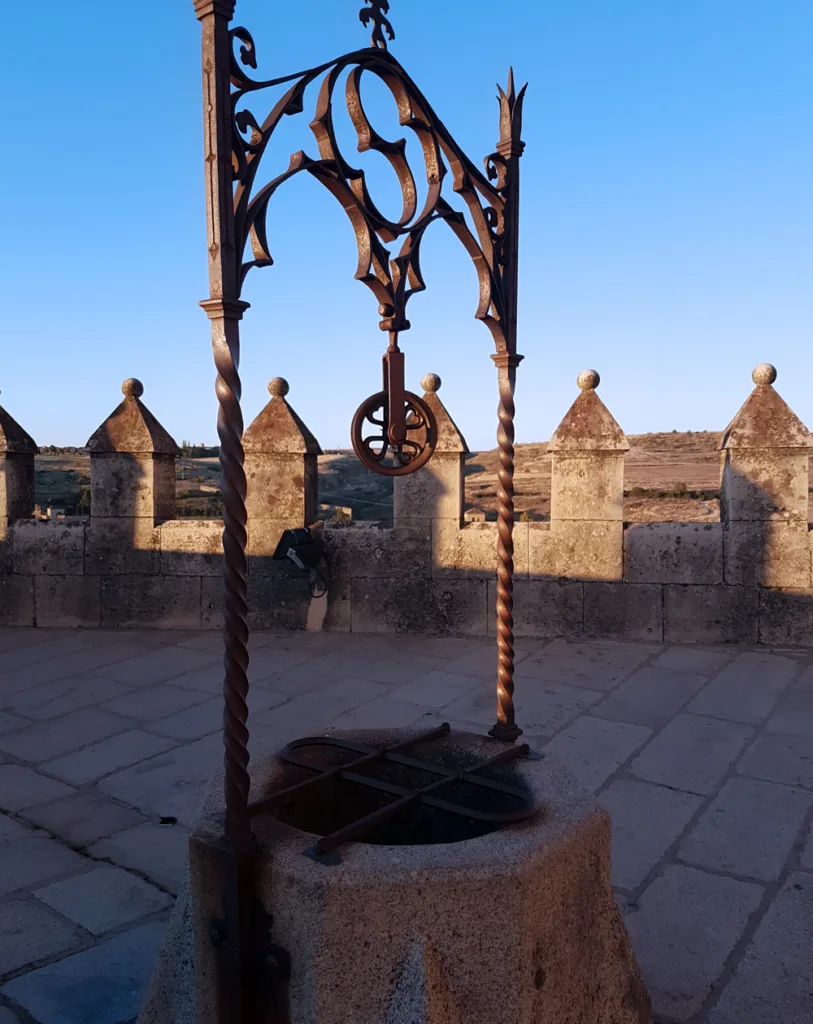
Visiting the Alcázar
The Alcázar castle of Segovia is a must-visit destination for those interested in history, architecture, and culture. Located in the heart of Segovia, this magnificent castle can be easily accessed by walking or by car (or public transportation).
The castle is open to visitors every day except for certain holidays. The operating hours typically running from morning to late afternoon. Admission fees vary, but a visit to the castle is well worth the cost.
When planning a visit to the Alcázar castle, it’s best to go in the early morning to avoid the crowds and to enjoy the best lighting for taking photos. Visitors should allow themselves plenty of time to explore the castle. There is much to see, including the impressive towers, spacious courtyards, and artworks it holds inside.

Concluding the visit to the Alcázar Castle of Segovia
The Alcázar castle of Segovia is a symbol of Spain’s rich history and cultural heritage. With its unique blend of Gothic and Mudéjar architectural styles, its impressive towers, spacious courtyards, and ornate decorations, this iconic landmark has captivated visitors for centuries.
From its origins as a military fortification to its later use as a palace and prison, the castle has played a significant role in the history of Segovia and Spain.
Today, the Alcázar stands as an important historical monument, recognized as a UNESCO World Heritage Site for its cultural, historical, and architectural significance.
For those looking to experience Segovia’s rich history, beauty, and cultural significance, a visit to the Alcázar is a wonderful must.


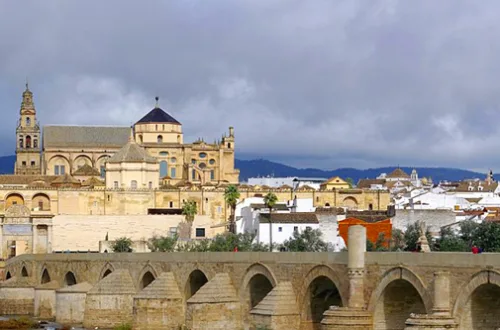
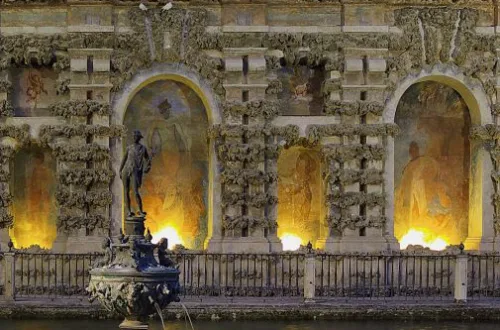

One Comment
Pingback: